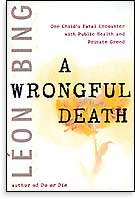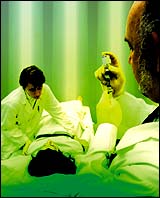
|

Exposing Mental Health Care Fraud
Psychiatric treatment has become a highly dangerous panacea for the emotional trials that many children and adolescents experience in growing up.
 By Léon Bing
By Léon Bing
Publisher: Villard Press
285 pages
Reviewed by Lori Jablons

he number of reported crimes, deaths and suicides committed by those under psychiatric treatment has reached an all-time high. Some prominent examples in recent memory: Daniel Jones, the HIV-positive California man being treated for his disease with “wads of Prozac” as reported in the Los Angeles Daily News, who committed suicide at a busy L.A. freeway interchange; Kip Kinkel, the Ritalin- and Prozac-taking teenager from Oregon, who, after murdering his parents, opened fire on his classmates in the school cafeteria, killing two and wounding 22. Receiving psychiatric drug treatment were singer Michael Hutchence, who hanged himself; actor Chris Farley, who overdosed on drugs and alcohol, and actor Phil Hartman’s wife, Brynn, who fatally shot Hartman as he slept and then killed herself.
The one thing all of these people had in common, save for Kinkel, was the choice they made to take these drugs. Kinkel was a “problem” child who was sent to see a psychiatrist, who prescribed them. “Problem” children—and non-problem children—are drugged every day. None have a choice, and this psychiatric treatment has become a highly dangerous and false panacea for problems in school and the emotional trials that many children and adolescents routinely experience.
Léon Bing’s A Wrongful Death chronicles the harrowing saga of the Scheck family. In November 1991 Merry and Bob Scheck committed their 13-year-old daughter, Christy, to Southwood Psychiatric Center in Chula Vista, California. On the evening of March 6, 1992, Christy Scheck was found hanged in her room, the sash from her terrycloth bathrobe tied around her neck.
In addition to the therapy Christy received as a patient at Southwood, she was heavily medicated. Her psychiatrist, Arthur Quinn, told Merry after Christy had been at Southwood for about three weeks that her daughter was “stuck” and the only thing that would “get her unstuck” was antidepressant medication.
“Christy was started on a daily dose of twenty-five milligrams of imipramine, a tricyclic antidepressant,” Bing writes. “When she complained of sleeplessness (a common side effect of the drug), Restoril, a mild sedative, was prescribed.”
The prescribed maximum dosage of imipramine for an adolescent is 100 milligrams. By her third month at Southwood, Christy was being given 150 milligrams of imipramine a day. She was also given Thorazine, which holds the distinct description as “a pharmacological substitute for lobotomy.”
Christy Scheck was an intelligent girl, a good student and a stellar athlete. When she was still very young, her father could see her athletic prowess. A talented baseball pitcher, she also played soccer on the boy’s team. In 1991, the year Christy turned 13, Bob Scheck decided that his daughter should no longer play on the boy’s soccer team. Without discussing the matter with her, Bob told Christy that she would be playing on the girl’s team. Christy expressed her rage at this decision to Ed Duenez, her school guidance counselor. Duenez tried to calm Christy and explained that it was for her own good, as soccer with teenage boys is much rougher and her father did not want her to get hurt. Christy was not placated.
In October 1991, the nurse at Christy’s middle school called Merry to tell her that Christy had come into her office showing bruises on both arms and one near her temple. Christy told the nurse that the one near her temple was caused by “her father ‘slugging her in the head.’” Merry realized that the bruise on Christy’s head had occurred during a soccer game two days earlier, when Christy was knocked into a goal post.
Christy became increasingly difficult to deal with. She would not communicate with her parents. She told wild stories of parental abuse to her friends. She started running away from home, but even when she was gone once for three days, she still chose to attend school. She had begun maiming herself with a compass point. The Schecks turned to a family therapist at the end of October. According to Bob Scheck, a career Navy man, “As long as we didn’t get into the ‘problem area,’ which was anything having to do with Christy’s relationship with us, and her anger at us—me in particular—things were okay. The peace was kept.” Yet, if the “problem area” could never be addressed, how could anyone ever have expected the family to come back together again?
After Merry found empty aspirin bottles and razor blades in Christy’s room, she and Bob started to consider committing Christy—as a last resort. Their family therapist recommended Southwood Psychiatric Center, as he had contacts there and knew staff psychiatrist Arthur Quinn. Merry also spoke to a friend who had committed her son to Southwood and she validated Merry’s choice to commit Christy.
On November 12, Merry received a call from Ed Duenez, who explained that Christy was “hiding her arms,” which showed further signs of self-inflicted abuse. Merry asked Duenez to speak with Christy, “to tell her that she needed to be in a place where she could get help.” Before Merry left her office that day, she called Southwood to confirm that the hospital would accept their insurance, CHAMPUS, a federal health insurance program that covers active and retired military personnel. The mental health benefits covered 150 days of in-patient care for adolescents committed to a residential treatment center; additional time could be added if necessary.
Duenez had the talk with Christy that Merry requested. He told her that her parents wanted to send her to a group home. He said this, admittedly, without having “made a personal investigation of the facility.” Christy went along without a struggle. Duenez stated that he “was shocked, really shocked, at how easily she went.” However, within an hour of Christy’s being admitted, Duenez received a phone call in which the “caller spoke in an urgent whisper, ‘Mr. Duenez, this isn’t a group home, it’s a psychiatric hospital. And, Mr. Duenez, I’m not crazy....’”
Merry, who called Southwood every night, could not get straight answers about her daughter’s progress, and Christy would neither speak to nor see her parents. Merry and Bob had to rely on the opinions of hospital staff members. Bob told Bing, “To this day, we don’t know what their treatment was.” When the Schecks finally had a family therapy session at the hospital, Christy became so enraged that she walked out. She eventually accused her father of sexual abuse, a charge promulgated by Southwood staff even though a gynecological exam failed to find any physical evidence to substantiate the claim. Regardless, Bob was legally restrained from seeing Christy, and the Scheck’s younger daughter, Molly, was removed from their home and placed in foster care.
Psychiatrist Arthur Quinn, who was responsible for Christy’s well-being and care, was no help to the anguished parents. He was reluctant to provide them with any solid information about their daughter’s condition and placed Christy, though not a drug user, in a drug-abuse group for “purely educational” purposes. The purposes, evidently, were purely financial. Quinn was the part-time director of the Dual Diagnosis Services Group at Southwood. If a patient was dually diagnosed with depression and alcoholism, for example, the hospital could charge for all the extra services and bill the patient’s insurance plan accordingly. The one piece of salient information Quinn provided was that Christy was having hallucinations, a side effect of the drugs she was taking. Christy’s dosage of imipramine, however, was never modified.
The evening of March 6, 1992, at approximately 8:30, was the last time anyone saw Christy Scheck alive.
The main target, and a legitimate one, of A Wrongful Death is a mental-health-care system gone awry. Bing illustrates a system in which the bottom line takes precedence over patient care and where insurance fraud is committed willingly and happily.
“Health Management Strategies, the reviewing arm of CHAMPUS, conducted a survey at Southwood in February 1991,” writes Bing. “Of the myriad of deficiencies found, the ones that would relate most directly, a year late, to Christy Scheck were the low staffing ratios, the therapy sessions conducted by unlicensed mental-health counselors and other unlicensed personnel, such as interns who led group meetings (particularly those groups involving sexual abuse), as well as other staff members who were both unlicensed and untrained in CPR.”
Bing writes how between 1980 and 1985, increases in CHAMPUS mental-health costs averaged 20 percent a year; between 1985 and 1989, the costs increased 126 percent, reaching $613 million, and during 1990 and 1991—the year Christy Scheck was admitted to Southwood—costs topped out at $631 million. In-patient mental-health care represented $500 million, or 79 percent of that total. And approximately $305 million of that was for the treatment of children and adolescents.
Bing details the insurance fraud that ultimately brought down National Medical Enterprises, the parent group of the Psychiatric Institutes of America, of which Southwood was a part. The goal at Southwood was to keep the beds filled at all times, with the best-insured patients.
Bing notes the horrifying commentary of NME marketing executive Alan Sidell about one aspect of their marketing strategy: “School systems were very big marketing arenas. And not just unified schools; we worked all the school systems.” Bing confirms this: “... a director from one NME-owned facility testified, during 1992 congressional hearings into health fraud, that he targeted kindergarten as part of his marketing strategy.”
The congressional hearings referred to occurred on April 28, 1992, the purpose of which was to shed light on the rampant misuse of insurance funds in the mental-health sector. As Bing writes, “The most succinct observation, made after listening to hours of testimony, came from Brooklyn Congressman Charles E. Schumer: ‘This is the closest thing to ultimate evil I’ve ever seen.’”
Bing illustrates a system in which the bottom line takes precedence over patient care and where insurance fraud is committed willingly and happily.
|
|
Much of NME’s illegally obtained profit went to pay off the largest fine ever levied in a medical-fraud case in U.S. history: $379 million to settle all federal criminal charges resulting from the fraud and abuse which permeated their entire psychiatric hospital chain. NME also paid out more than $300 million to settle hundreds of civil lawsuits filed by former NME patients and by insurers.
The Schecks sued Southwood, and eventually settled out of court in July 1994 for an undisclosed amount.
Leon Bing does a superb piece of reportage in A Wrongful Death. And the horror of what happened to Christy Scheck should be known by everyone. But the real villain here is the evanescent practice of psychiatry, a non-exact, non-productive and very subjective “science.” Psychiatry has all but been replaced by psychopharmacology. Since practitioners have not yet developed a therapy that works, they have created drugs that decrease the user’s awareness so the problems do not seem so bad, and they get rich in the process. Just think: If psychiatry actually worked, actually helped people, there would be no Prozac or imipramine. If psychiatry actually worked there would be no Kip Kinkels gunning down a cafeteria full of classmates. If psychiatry worked, Christy Scheck would still be alive.
|

|

 By Léon Bing
By Léon Bing





